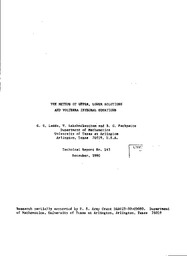
ATTENTION: The works hosted here are being migrated to a new repository that will consolidate resources, improve discoverability, and better show UTA's research impact on the global community. We will update authors as the migration progresses. Please see MavMatrix for more information.
Show simple item record
| dc.contributor.author | Ladde, G. S. | en |
| dc.contributor.author | Pachpatte, B. G. | en |
| dc.contributor.author | Lakshmikantham, V. | en |
| dc.date.accessioned | 2010-06-02T20:47:12Z | en |
| dc.date.available | 2010-06-02T20:47:12Z | en |
| dc.date.issued | 1980-12 | en |
| dc.identifier.uri | http://hdl.handle.net/10106/2254 | en |
| dc.description.abstract | **Please note that the full text is embargoed** ABSTRACT: In employing the method of upper and lower solutions to dynamical systems, one is required to impose a certain monotone property on the given system [5,6,11] When the given system does not possess such a monotonic property, stronger forms of upper and lower solutions have to be assumed in order to obtain similar results [4,6,9]. Furthermore, if the system enjoys a mixed monotone property the method of quasi-upper and lower solutions, which is recently introduced, is most useful [7]. In this paper we shall extend these ideas to Volterra integral equations.
We want to note that Volterra integral equations and inequalities which can not be reduced to differential ones were first considered in [1,10], We shall first consider various aspects of Muller's type result and then develop monotone
iterative technique to establish the existence of coupled quasi-minimal and
maximal solutions. | en |
| dc.language.iso | en_US | en |
| dc.publisher | University of Texas at Arlington | en |
| dc.relation.ispartofseries | Technical Report;143 | en |
| dc.subject | Volterra integral equations | en |
| dc.subject | Mixed monotone property | en |
| dc.subject | Coupled solutions | en |
| dc.subject.lcsh | Volterra equations | en |
| dc.subject.lcsh | Mathematics Research | en |
| dc.title | The Method of Upper, Lower Solutions and Volterra Integral Equations | en |
| dc.type | Technical Report | en |
| dc.publisher.department | Department of Mathematics | en |
Files in this item
- Name:
- MathTechReport143.pdf
- Size:
- 347.6Kb
- Format:
- PDF
- Description:
- PDF
This item appears in the following Collection(s)
Show simple item record


